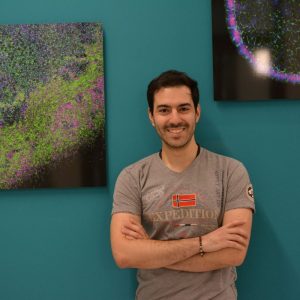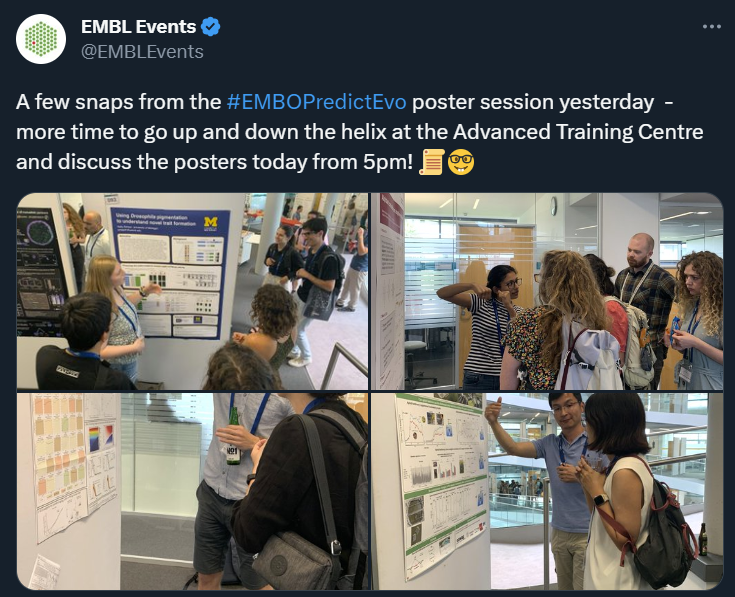Poster prizes at ‘Predicting evolution’
The EMBO Workshop ‘Predicting evolution‘ took place last month, exploring the evolution of biological systems at different levels: from genes and molecules to organism development and ecology. The meeting brought together leaders in their respective fields across various scales of evolution: molecular, network, microbial, developmental, and community.
This time, we had 120 people attending on site (and 50 virtually), including 16 fellowships provided by the EMBL Corporate Partnership Programme and EMBO. After the virtual 2021 edition, it was a fantastic opportunity to meet in person again and catch up with the community during the four days’ programme full of outstanding science. We held two poster sessions up on the helices of the Advanced Training Centre during which the presenters could discuss their research – their work was then voted for by other attendees and speakers. We are pleased to share with you the five best poster prize winners!
Additivity, dominance and epistasis in the evolutionary trajectory of a developmental enhancer
Presenter: Noa Ottilie Borst

Abstract and poster:
Due to the confidentiality of the unpublished data, at present we can share neither the poster itself nor the abstract. Reach out to Noa if you would like to know more!
Genomic context and the collateral consequences of gene duplication/amplification during bacterial evolution
Presenter: Ryan Fritts

Abstract:
The evolution of new enzymes with novel molecular activities can drive adaptation to new niches. New enzymes often evolve from preexisting enzymes that have inefficient side activities. These promiscuous side activities are normally physiologically irrelevant but can serve as the basis for evolving a new enzyme. Selection for higher expression of an enzyme with a newly advantageous but weak side activity frequently leads to gene duplication/amplification to increase its cellular dosage. Gene amplification allows an organism to retain an enzyme’s ancestral function while simultaneously refining the promiscuous activity in the new copies. However, collateral consequences can arise from gene amplification as these events usually amplify large genomic segments. Thus, the overall fitness benefit derived from an amplification will depend on what and how many genes are co amplified with the gene(s) under selection for higher dosage.
The Copley lab has developed a model system to study the evolution of new enzymes by gene duplication and divergence. The nonhomologous reductases ArgC and ProA catalyze similar reactions in arginine and proline biosynthesis, respectively. Deletion of argC in Escherichia coli abolishes arginine biosynthesis. A point mutation in proA (proA) that causes an E383A substitution near ProA’s active site improves its promiscuous ArgC activity, restoring arginine production. However, the ArgC activity of ProA is much worse than ArgC. ProA* is also attenuated in its native activity. The poor catalysis of these two biosynthetic steps limits growth rate in minimal medium. Laboratory evolution of an ΔargC proA* E. coli strain showed that proA* rapidly amplifies at its native locus alongside many neighboring genes, reaching >10 copies in most cases. We then sought to determine how genomic context might affect proA* amplification. We deleted the proBA* operon from its native locus and relocated it next to genes that might impair fitness if overexpressed due to co amplification. We evolved the proBA* relocation strains in a turbidostat for 150 200 generations. proA* amplified in almost every population, although amplification size and copy number varied between the different relocation sites. We are now characterizing the transcriptomic and proteomic ramifications of gene amplification.
View poster (please note, parts have been greyed out due to the confidentiality of the unpublished data)
Gradual versus abrupt environmental change: implications for clonal dynamics, fitness preservation, and evolutionary predictions in yeast populations
Presenter: Shahar Rezenman

Abstract:
Environmental stress requires adaptation and imposes selection and is, therefore, a driving force of evolution. But although stress response has been studied extensively across abiotic conditions and taxa, little attention has been given to the implications of the rate at which stress is applied. We set out to study how the application of gradual and abrupt stresses affects evolution from the perspective of clonal dynamics, offering an opportunity to examine the processes that influence evolution and its reproducibility.
We constructed a custom barcoding system in the yeast Saccharomyces cerevisiae. Using this system, we followed the clonal dynamics of populations experiencing gradual and abrupt heat stress (30°C to 39°C within a week or an hour, respectively, and for 250 generations following). We grew the populations in turbidostats to minimize genetic drift, avoid bottlenecks inherent to serial dilution protocols, and avoid switching between lag, exponential, and stat phases. With our barcoding method, copies of populations are identical in barcode makeup, allowing us to ask questions about reproducibility and the role of deterministic processes.
We found that following gradual induction of heat stress, the populations maintain higher diversity and survivability of clones compared to abrupt exposure. In fact, the population structure remains relatively unchanged under gradual application, with lineages maintaining fitness throughout, resulting in similar dynamics between repeats. Conversely, the abrupt application of stress brought about a considerable decrease in lineage diversity. This led to reshuffling in the population makeup, resulting in distinct dynamics emerging between repeats as the fitness of clones changed over time.
Overall, our findings suggest that not only the magnitude but also the rate of environmental change is crucial and should be considered carefully when making predictions about evolution.
Due to the confidentiality of the unpublished data, we cannot share the poster.
Stronger metabolic entanglement emerges from the co evolution of mutualistic partners
Presenter: Giovanni Scarinci

Abstract:
Mutualistic dependencies based on metabolite exchanges are common in the microbial world, often resulting in the inevitable coexistence of partners. Such exchanges can differ in terms of number, nature, and fluxes, thus imposing different levels of metabolic interdependence between organisms. These observations suggest that trading partners can, over the time of their co evolution, change and increase their trades, and therefore their dependencies, resulting in a stronger entanglement. However, the evolutionary dynamics and the underlying processes that increase the interdependence of two originally autonomous organisms remain elusive. In order to reveal these dynamics, we engineered a model bipartite cross feeding community between bacteria and yeast auxotrophs and we evolved it via serial passages. The evolved community showed a strong reduction in the lag phase and an increase in the growth rate. Whole genome sequence analysis showed that this increased performance was caused by a small set of mutations that were individually characterized and displayed a reproducible pattern in the order of their appearance within the co culture among different replicates. These mutations were proven to confer benefits either to the organism or the trading partner. Additionally, most of them reinforced the pre existing interactions (e.g. overproduction of the traded compounds, increase in uptake). Interestingly, molecular and metabolic analysis revealed that the evolved yeast lost essential metabolic functions, specifically the ability to directly assimilate ammonia, thus resulting in an increased dependency on the bacterial partner compared to the ancestral counterpart.
Due to the confidentiality of the unpublished data, we cannot share the poster.
High resolution adaptive landscapes of bacterial transcription factor binding sites
Presenter: Cauã Westmann

Abstract:
New patterns in gene regulation are central mechanisms for the evolution of novel traits in biological systems. In prokaryotes, transcriptional regulation is primarily mediated by transcription factors (TFs), which bind to specific DNA sequences called transcription factor binding sites (TFBSs), regulating gene expression through the modulation of RNA polymerase activity. Mutations in TFBSs are thought to play a major role in the evolution of gene regulation, yet little is known about the molecular origins of these regulatory elements, particularly in bacteria. In this study, we describe a novel approach to generating high resolution adaptive landscapes of bacterial TFBSs in vivo for any desired TF, using a modular plasmid based system in Escherichia coli. We combined fluorescence based cell sorting and high throughput sequencing (sort seq) to characterize hundreds of thousands of TFBSs for four bacterial TFs, including two local and two global regulators. By analyzing these landscapes, we aimed to address fundamental questions regarding the origins and predictability of regulatory innovations. Our analysis revealed that although the studied landscapes were multi peaked and epistatic, theoretically making them difficult to navigate by natural selection, high peaks were often more accessible than expected. Moreover, we generated sequence function maps that can be used to predict TF TFBS binding strengths and identify novel regulatory motifs. Our findings offer new insights into the evolution of bacterial transcriptional regulation and contribute to current endeavors to predict and design synthetic regulatory elements with desired properties in bacteria.
Due to the confidentiality of the unpublished data, we cannot share the poster.

The EMBO Workshop ‘Predicting evolution’ took place from 11 – 14 July 2023 at EMBL Heidelberg and virtually.